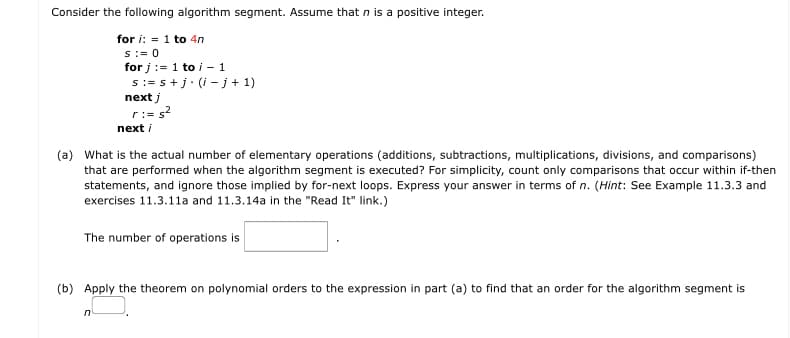Consider the following algorithm segment. Assume that n is a positive integer. for i: = 1 to 4n s:= 0 for j:= 1 to i - 1 s:= s+j• (i -j+ 1) next j r:-s? next i (a) What is the actual number of elementary operations (additions, subtractions, multiplications, divisions, and comparisons) that are performed when the algorithm segment is executed? For simplicity, count only comparisons that occur within if-then statements, and ignore those implied by for-next loops. Express your answer in terms of n. (Hint: See Example 11.3.3 and exercises 11.3.11a and 11.3.14a in the "Read It" link.) The number of operations is (b) Apply the theorem on polynomial orders to the expression in part (a) to find that an order for the algorithm segment is
Consider the following algorithm segment. Assume that n is a positive integer. for i: = 1 to 4n s:= 0 for j:= 1 to i - 1 s:= s+j• (i -j+ 1) next j r:-s? next i (a) What is the actual number of elementary operations (additions, subtractions, multiplications, divisions, and comparisons) that are performed when the algorithm segment is executed? For simplicity, count only comparisons that occur within if-then statements, and ignore those implied by for-next loops. Express your answer in terms of n. (Hint: See Example 11.3.3 and exercises 11.3.11a and 11.3.14a in the "Read It" link.) The number of operations is (b) Apply the theorem on polynomial orders to the expression in part (a) to find that an order for the algorithm segment is
Advanced Engineering Mathematics
10th Edition
ISBN:9780470458365
Author:Erwin Kreyszig
Publisher:Erwin Kreyszig
Chapter2: Second-order Linear Odes
Section: Chapter Questions
Problem 1RQ
Related questions
Question
Please help me with this. Please show the step too!

Transcribed Image Text:Consider the following algorithm segment. Assume that n is a positive integer.
for i: = 1 to 4n
s:= 0
for j:= 1 to i – 1
s:= s+j• (i - j + 1)
next j
r:= s?
next i
(a) What is the actual number of elementary operations (additions, subtractions, multiplications, divisions, and comparisons)
that are performed when the algorithm segment is executed? For simplicity, count only comparisons that occur within if-then
statements, and ignore those implied by for-next loops. Express your answer in terms of n. (Hint: See Example 11.3.3 and
exercises 11.3.11a and 11.3.14a in the "Read It" link.)
The number of operations is
(b) Apply the theorem on polynomial orders to the expression in part (a) to find that an order for the algorithm segment is
Expert Solution
This question has been solved!
Explore an expertly crafted, step-by-step solution for a thorough understanding of key concepts.
This is a popular solution!
Trending now
This is a popular solution!
Step by step
Solved in 3 steps with 1 images

Recommended textbooks for you

Advanced Engineering Mathematics
Advanced Math
ISBN:
9780470458365
Author:
Erwin Kreyszig
Publisher:
Wiley, John & Sons, Incorporated

Numerical Methods for Engineers
Advanced Math
ISBN:
9780073397924
Author:
Steven C. Chapra Dr., Raymond P. Canale
Publisher:
McGraw-Hill Education

Introductory Mathematics for Engineering Applicat…
Advanced Math
ISBN:
9781118141809
Author:
Nathan Klingbeil
Publisher:
WILEY

Advanced Engineering Mathematics
Advanced Math
ISBN:
9780470458365
Author:
Erwin Kreyszig
Publisher:
Wiley, John & Sons, Incorporated

Numerical Methods for Engineers
Advanced Math
ISBN:
9780073397924
Author:
Steven C. Chapra Dr., Raymond P. Canale
Publisher:
McGraw-Hill Education

Introductory Mathematics for Engineering Applicat…
Advanced Math
ISBN:
9781118141809
Author:
Nathan Klingbeil
Publisher:
WILEY

Mathematics For Machine Technology
Advanced Math
ISBN:
9781337798310
Author:
Peterson, John.
Publisher:
Cengage Learning,

